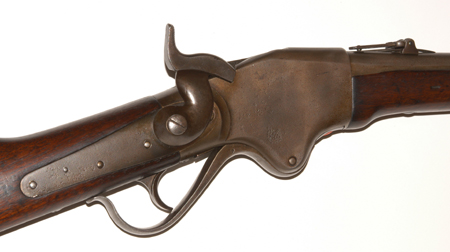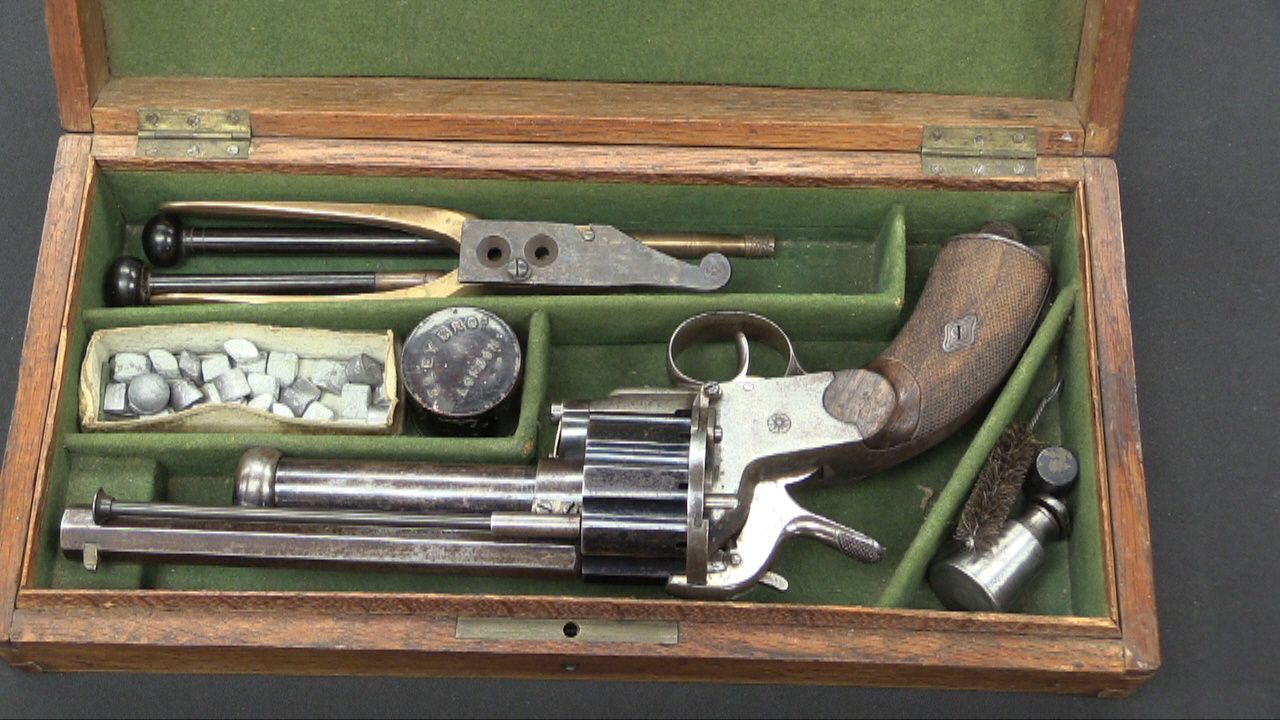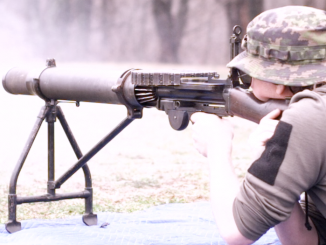Standard Arms was an early (circa 1909) manufacturer of self-loading hunting rifles in the US. The made the Model G, a rifle which could function either as a self-loader or a pump action manual repeater. Unfortunately, is was tremendously unreliable and prone to breakage. In an effort to salvage something of use, the company introduced the Model M – a pump-only version. It can’t malfunction if it doesn’t try to function on its own, right? Well, it didn’t work, and the company went bust in 1912, and then again in 1914 after its creditors attempted to revive it.
However, one really rare model that Standard Arms also produced was the “Camp”. This is a .50 caliber smoothbore pump-only gun chambered for a proprietary cartridge similar to the .50-95. It was intended for shooting either small shot or single round lead ball loadings, rather like the Ishapore Arsenal single-shot SMLE conversions. Only an estimated 25-30 of the Camp guns were built, and this example is in outstanding condition.




The cartridge reminds me of the.44 round used in Marble’s Game Getter.
Shot or round ball options based on the .44-40.
Game Getter is most well-known weapon to use .44 shot cartridge, but other weapons were also available http://www.fourten.org.uk/mwpre410.html
…number of small shot guns were available which used a variety of .44 shot cartridges more or less interchangeably. These guns included not only the fairly common little break-open single barrel guns like my friend’s, but smooth-bored Winchester lever action rifles, Colts Lightning slide action rifles, a few Colts big frame revolvers, Stevens single-shot, break-open pistols (commonly called “pocket shotguns”), and the last and possibly most famous gun to use the .44 shotshells, the Marble’s Game Getter. Indeed, the Marble’s Game Getter is so closely associated with the .44 shotshells that old cases often were marked “.44 GG.”
The .44-40 shot cartridges appeared in a number of variations. The most common types include: a standard length case with over shot card and roll crimp; a standard length case with a shot-filled paper or wooden capsule which gave the cartridge the profile of a cartridge loaded with a bullet; an extra long case with either an over shot card and roll crimp or a folded or “pie crimp” loaded to the bulleted cartridge profile and providing room for a little more shot; and versions which uses a paper or wooden capsules to extend its length so that it could hold a little more shot.
In addition to these variations, which do not exceed the maximum overall length of the loaded .44-40 cartridge, there is a more or less interchangeable cartridge called the .44 XL. The .44 XL used an even longer paper or wooden capsule to hold more shot. It was loaded to an over all length of about two inches. Obviously this is too long to work in a revolver or short action repeater such as the Winchester 73 and Colts Lightning rifles, but works in a break open single shot.
interestingly shot variations were not limited to .44-40 cartridge as very similar shells were made up in .38-40 cases, .32-20 cases and any number of others along with smoothbore guns to shoot them albeit last were less popular
for images of “bullet-profile” .44-40 shot-cartridge see https://shop.ammo-one1.com/product.sc?productId=146
OK, what is the dividing line between a musket and a shotgun firing slugs? Is there any?
“Musket” has always been a word with a slippery meaning. Originally it was a “heavy” arquebus, capable of penetrating armor, and so differentiated from the standard infantry weapon by that name. The word then meant any shoulder arm (presumably firing single balls) until the advent of the “rifled musket” which itself faded into just “rifle.” “Musket” stuck around (at lease in the US) for rifled breech-loading arms that were fully-stocked to the muzzle and usually intended for military training and drill — the Winchester 1885 was offered in a “musket” version at least until World War One. I don’t remember for certain if the term was applied to any repeating arms such as the Winchester lever-actions (using the term “musket-style” or “musket-stocked” perhaps). So I suppose the distinction is that a shotgun can shoot shot, even if it can shoot slugs, and a musket usually cannot shoot shot, and, at least in the early 20th-century USA, could be rifled.
All the 19th century Winchester lever rifles were offered in “musket” configuration. Few sold many copies other than the 1895.
The Savage 1895 Lever Action (which was a close developmental predecessor of the Savage 99)
Was available as “musket” and was adopted as a musket by one of the Canadian provincial militias. I think Ontario.
As well as being entered in united state army rifle trials.
There’s at least one repeating action “musket” in Canada.
Not Ontario, one province east, it was adopted by the Montreal Home Guard in Quebec.
When stumbling at confusing English word I most often consult https://archive.org/details/con00ciseoxforddicfowlrich it does not know what shotgun is, but it does states that
mu’sket, n. Infantry soldier’s hand-gun (now usu. of obsolete kinds, cf. RIFLE);
Therefore we can conclude that calling weapon mu’sket imply it is destined for military-infantry use.
That single lead ball from a smoothbore shotgun is the “punkin ball” of ill repute. 40-ish years ago I knew people who used and loathed them before shotgun slugs were approved in this area. Given the proximity, who knows how things would have turned out if they had approached DuPont at the time
Cartridge you can choose any of…
http://old.municion.org/semi/32.htm
the ammunition that you’re describing sounds a lot like 32 bore shotgun cartridges, it would be interesting to see if the chamber dimensions match.
Lots of 32 bore/14mm single shot bolt action shotguns are still sold in France some with silenced barrels although the silenced 12mm/ 2 inch 410 is quieter. Back in the 60’s in Ontario Canada a family friend gave me a Hopkins and Allen smooth bored falling block rifle chambered in 38XL. I used 38 special cartriges loaded with a full 9×19 case of black powder and 2 .36 round balls for navy colt revolvers. The 2 balls would print about an inch apart at 25 yards(premetric days) and would completly penetrate into a maple tree.I always wanted to shoot a deer with it but thank goodness never ran into a deer while carrying it
This 32 (12.7mm) caliber has always (since its inception) been popular with professional hunters.
It allows them to significantly save gunpowder and lead, which is very important for residents of remote places where there is no sporting goods store around the corner.
It allows you to confidently take animals up to a white-tailed deer, a wolf, a one-year-old wild boar or a medium-sized bear.
The preference has always been given to all-metal brass cases.
I have never seen any metal shotshells in France except some postwar 16 gauge all aluminium ones. When we took over my wifes grandmothers house in the south charente France in 1984 we bought a beagle pup hens jungle fowl pigeons and mallard ducks
I like to see birds flying so I clipped no wings.Shooting pigeons was no problem put down some corn and wait with the 9mm rimfire flobert till they came down to eat At 5 metres you got them every time. I even made a silenced barrel so not to scare the other birds But the mallards were another story forget the 9mm it would only kill up to about 10 metres with a head shot. The 12mm/2inch 410 was much better but wounded ducks got away and were savaged by the beagle pup.A friend lent me a 14mm and after that I had no problems up to about 20 metres and I am not a good wingshot. Apparently however although they are still made and sold the 14mm is losing out to the 3 inch 410 often loaded as a subsonic cartrige for silenced shotguns which have been legal to hunt with in France for about 3 years
“…I have never seen any metal shotshells in France…”(С)
This only means that you did not come across them.
In France. 😉
https://www.liveauctionworld.com/ASSORTED-32-GA-COLLECTIBLE-SHOT-SHELLS_i42483319
https://www.liveauctionworld.com/ASSORTED-COLLECTIBLE-BRASS-SHOT-SHELLS-SOME-WITH-PRIMERS_i42483322
There are also remakes
https://www.ballisticproducts.com/MagTech-32ga-2-1_2-empty-brass-shotshells-for-reloading/productinfo/3923265/
In general, 32 is the smallest caliber, which is still suitable for hunting anything larger than a rat.
Interestingly, someone knows from what dream of the mind this 410 appeared?
Completely pointless ammunition…
Very nice gun !